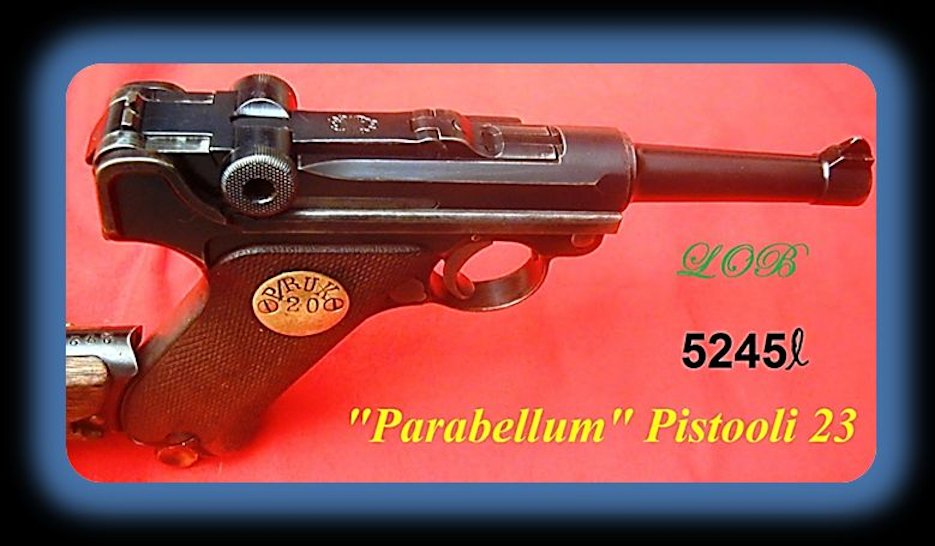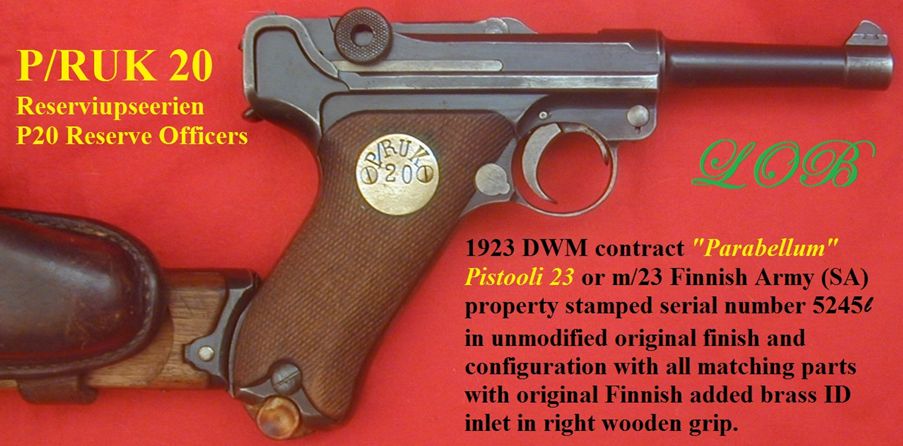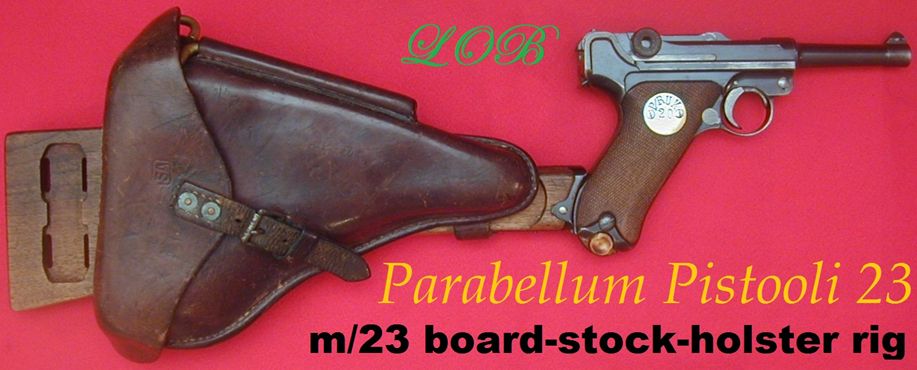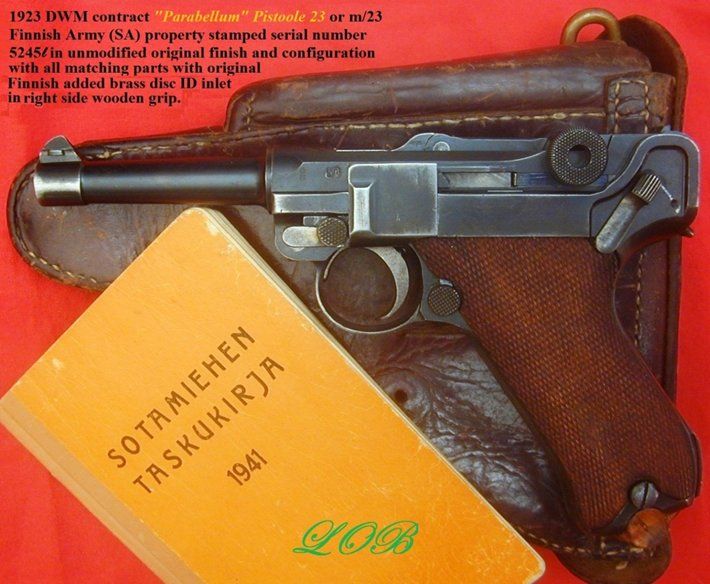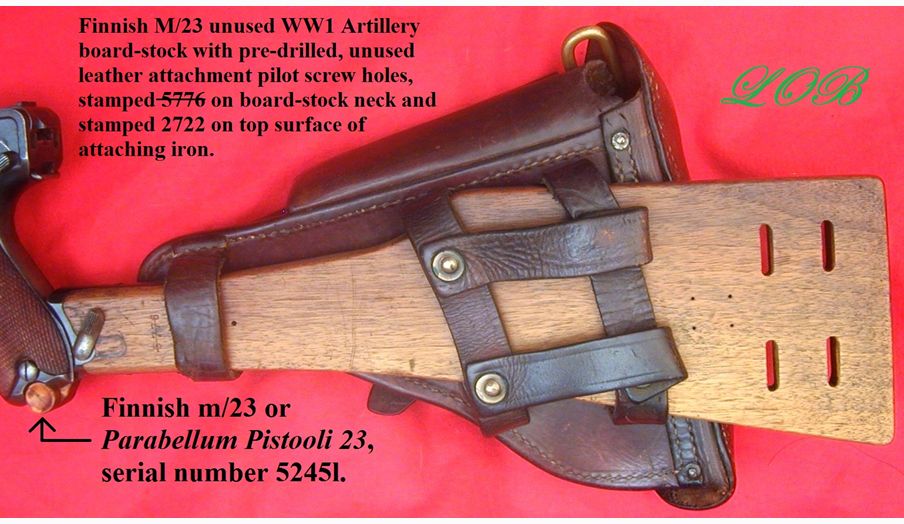buttons
Finnish military contract m/23 or „Parabellum” Pistooli 23
As shown in the advertisement below: DWM FINNISH MILITARY; 30 LUGER; 50% blue, very good bore, good grips, 3.75'' barrel, A 1920 Commercial with Crown N proofs. Finnish SA marked left front receiver. Finnish disc set into right grip panel. Unmarked wood bottom magazine. Finish (especially the front and rear gripstraps) shows wear from use and handling but no rust or pitting. Rig, includes a brown leather holster SA marked on the front of the flap. With brass cleaning rod and SA marked takedown tool. The holster (Example 1) has the four holes on the back where it was removed from the stock. (incorrect description), s/n 52xxl, Catalog Number D-236
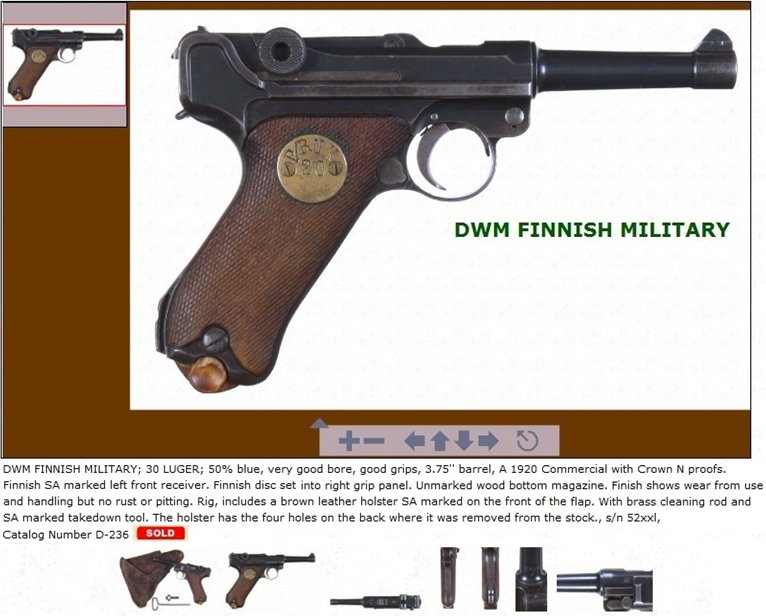
Featured is an extremely rare, Model 1923 DWM vertical crown N commercial proofed contract Finish military Luger rig, serial number 5245l with the original DWM factory bluing and with all matching small parts and amazingly, still sporting the Finnish depot installed brass unit-marked ID disc, inlet into the right wooden grip, retained by two counter bore, pan-head, flush mounted slotted brass screws. The frame and correct length 96mm 30 Cal crown N commerially proofed barrel are stamped with the full serial number. The last two digits of the serial number are found on all the typical components of a 1920s commercial Luger, being on the trigger, take-down lever, side plate and the rear link. The middle link and breechblock typically lack the serial number, the breechblock is crown N proofed. The magazine is a correct 1920s commercial magazine, however, lacking an SA property stamp.
Apparently, the the fitting of the brass disc into the the right grip was not a haphazard or rushed affair, at least with 5245l, as the the disc shows evidence of very careful fitting. Since a disc, by definition is flat, extra care was taken to make the disc, which is xx mm in diameter, extending into the curved portion of the wooden grip, conform to the forward and rear curved contour of the right wooden grip by filing down the outer circumference edges, flush to the wood. The most interesting aspect of the fit is that it included the outer edges of the forward securing pan-head screws, which meant the fitting was done after the brass disc was installed, amazingly, without any damage to the surrounding wooden grip.
The holster has an SA stamped brass handle cleaning rod and a SA stamped loading tool with an additional two-digit number 55 stamped next to the SA. According to the dealer the gun and holster were recently imported from Sweden, of which the dealer, which has been in business since the 1970s, additionally states that he has seen only three similar unaltered, original DWM rust blue finish, m/23 Parabellum pistols with intact brass disc ID Finnish m/23 examples in his lifetime.
Based on the serial number l suffix, the pistol was manfactured in the mid 1920s and entered the Finnish military arsenal in the same time frame. The Finnish depot left side receiver SA stamped in a rectangular cartouche, was not applied until the early 1940s, when the SA property stamp was instituted. The "SA" stands for Suomen Armeiji or Finnish Army property stamp, adopted early 1942 to signify that the weapon was the property of the Finnish Army.
The only known example of a foreign wall chart for the Pistooli m/23 is shown here.
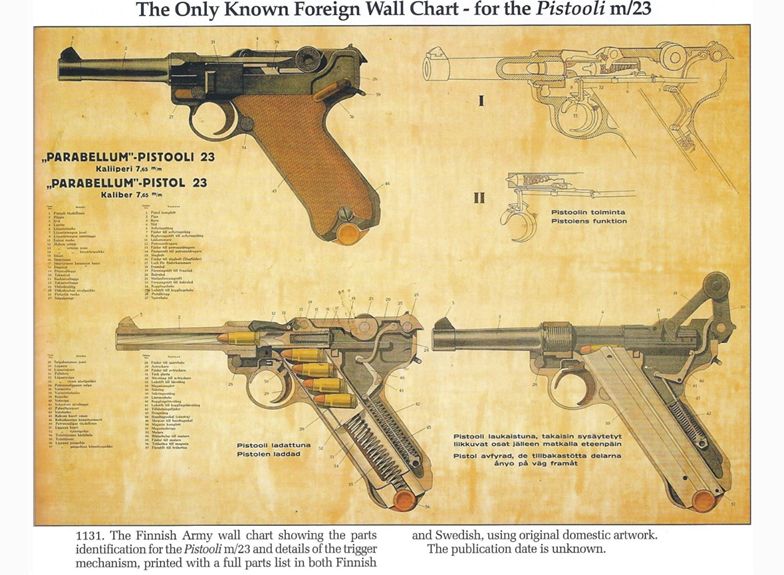
Close-up of cut-away view of Pistooli m/23 on wall chart shown below. 
|
As to when the unit-marked brass disc ID was added to the right side grip is not known, certainly between 1925 and 1940, when in 1940 the system was abandoned and all ”in inventory” m/23 Parabellum pistols with brass discs were removed. The P/RUK 20 stamped brass disc translates to P 20 Reserve Officers School, which, in Finnish is P 20 Reserviupseerikoulo. The 20 could refer to the the issue number as defined by Walter, however, the meaning of the P is unknown at this time, but could be as simple as Pistooli. It should be noted that the majority of the m/23 Parabellum pistols were issued, mainly to the Finnish army, and to a lesser extent to the Air Force with about 19 known, based on the issue number 19 in the center of the brass disc,


Reserve Officer School (Finnish: Reserviupseerikoulu, RUK), located in Hamina by the South-Eastern border, is the unit responsible for the training of the bulk of the Finnish reserve officers….Organizationally, Reserve Officer School is a brigade-level unit which belongs to the Eastern Finland Military Province. The unit was founded in 1920 and has operated continually with a single break from 1945 to 1947 when the Finnish officer training was stopped by order of the Allied Control Commission. Since its founding, the school has been situated in Hamina, with the exception of war-time 1939–1945, when the school was evacuated to Niinisalo in Kankaanpää. During the years 1942–1945, the school operated under the name of Officer School (Finnish: Upseerikoulu). Since 1920, the School has trained over 160,000 reserve officers for the Finnish Defense Forces. Pictured is a rare 1929 photograph of the Reserve Officers School reservists shooting the m/23 Parabellum Pistooli with board-stocks. For more information on the Finish Reserve Officer School, click here.
John Walter is the only Luger author that makes a good effort attempt to understand the various m/23 brass disc stampings, presents the best explanation for the m/23 brass ID markings where he states: (iv) Unit markings are somewhat similar to the German form, but lie on a brass butt disc used 1925-40 only). They usually comprise a company number and the unit identifier around the periphery, with the large issue number (from 1 to about 250 in some cases) in the centre.1 Some brass disc IDs are easily translated, like the subject m/23 5245l ”P/RUK 20-Reserve Officers School” or Reserviupseerikoulu, RUK, some are difficult, such as ”HämRjP” and some are outright long, like KKK-2-KSR or Konekiväärikomppania, Keski-Suomen Rykmentti (MG coy, Central Finland Regiment).

Being a Finnish Reserve Officer School pistol and subsequent possible lack of battlefield exposure, could explain the original condition survival, albiet with a significant loss of finish, with the gun being retained by the possesing officer during and after WW2. Also amazing is the survival of the brass disc insert, seeing that they were almost all removed before or during WWII by the Finnish military for security reasons and any surviving guns, still with brass discs, were probably removed in a late 1980s export of the guns, which were mostly hot dip blue arsenal reworks with replacement Tikka barrels of various lengths and calibers.
A military reserve force, sometimes called a military reserve, is different from a reserve formation. A military reserve is a group of military personnel or units not committed to a battle by their commander so that they are available to address unforeseen situations, bolster defenses, or exploit opportunities.



